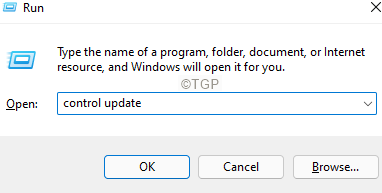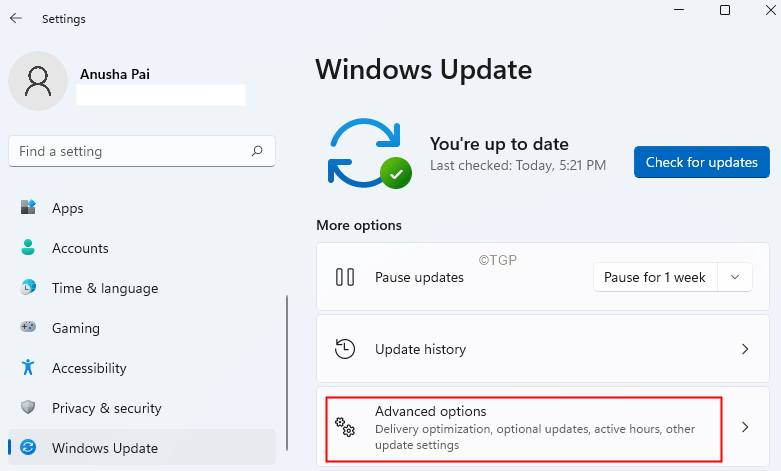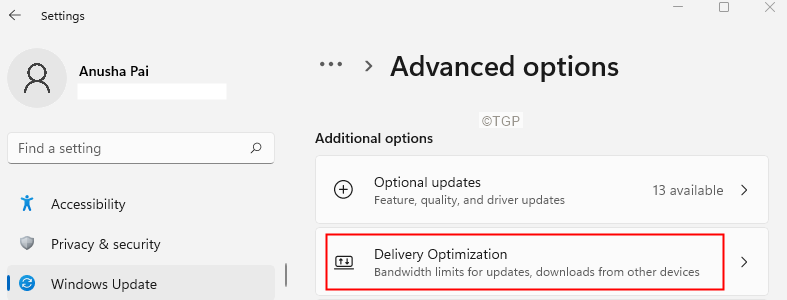Most of the time, we notice that even when there is internet connectivity, the speed is really slow. If you are seeing the Slow Internet or Slow Connectivity issues in your system, consider trying out the below fixes.
Fix 1: Turn Off Peer-to-Peer Update
When you have various Windows computers within the same network, the Peer-to-Peer Update feature allows sharing the Windows Update with these computers. While this is good in certain cases, you might see slow internet connectivity issues. To turn off this feature, follow the below steps:
Step 1: Open Run Dialog with Windows+R.
Step 2: Type control update and click on the Ok button.
Step 3: Click on the Advanced options.
Step 4: Scroll down to the Additional options section and then click on Delivery Optimization.
Step 5: In the opening window, under the Allow downloads from other PCs section, toggle the button to turn it Off as shown below
In case this doesn’t help, try out the next fix.
Fix 2: Modify the Internet Bandwidth Settings
Note: This Fix works only in Windows Pro versions.
Step 1: Open Run Dialog with Windows+R.
Step 2: Type gpedit.msc and click on the Ok button.
Step 3: In the local Group Policy Editor, navigate to the below location.
Administrative Templates > Network > QoS Packet Scheduler
Double-click on the selection, to expand it.
Step 4: On the right-hand side, double-click on Limit reservable bandwidth.
Step 5: In the appearing window, check the Enabled option.
Step 6: Set the Bandwidth limit to 0.
Step 7: Click on Apply and then click on OK.
Fix 3: Keep your WiFi Drivers up to date
Step 1: Hold the keys Windows and R to open the Run Terminal window
Step 2: Type devmgmt.msc and hit Enter

Step 3: In the Device Manager window that opens, scroll down and double-click on Network adapters
Step 4: Right-click on Intel(R) Dual-band Wireless-AC 7260 and click on Update Driver

Step 5: In the Update Drivers window, click on Search Automatically for drivers

Step 6: System searches and you will be notified of any updated drivers are found.
Step 7: Follow the onscreen instructions and update the drivers.
Check if this helps, if not do the following:
Step 8: In the Update Drivers window, click on Browse my computer for Drivers

Step 9: Click on Let me pick from a list of available drivers on my computer

Step 10: From the list of Compatible drivers, select the one that is not being used currently and click on Next
Many users have reported that using the driver from Microsoft has helped them solve the issue.

Step 11: Wait for the driver to be updated and follow the onscreen instructions to complete the process.
If you still see the issue, choose another driver from the list, try the drivers one after another until the issue resolves.
Fix 4: Turn Off Auto Tuning Feature
Step 1: Open the Run Terminal. Use the shortcut Windows+R.
Step 2: Type cmd and hold the keys Ctrl+Shift+Enter to open the Command Prompt in Admin mode.

Step 3: If you see a User Acess window showing up seeking permission, click on Yes.
Step 4: In the command prompt window that opens, type the below command
netsh interface tcp show global
Step 5: Check the value corresponding to the Recieve Window Auto-tuning Level. If the value is Normal or enabled, turn it off using the below command.
netsh int tcp set global autotuninglevel=disabled
Step 6: Check if you are able to resolve the slow Internet issue. If not within the command prompt execute the below commands to flush the DNS entries
IPCONFIG/FLUSHDNS
Now, check if the issue has been fixed. If not try the next fix.
Fix 5: Disable the Large Send Offload
Step 1: Hold the keys Windows and R to open the Run Terminal window
Step 2: Type devmgmt.msc and hit Enter

Step 3: In the Device Manager window that opens, scroll down and double-click on Network adapters.
Step 4: Right-click on Ethernet Adapter and choose Properties.
Step 5: Go to the Advanced tab.
Step 6: Under the Property section, choose Large Send Offload v2(IPv6)
Step 7: Under the Value section, choose Disabled.
Step 8: Click on the OK button.
Step 9 : Under the Property section, choose Large Send Offload v2(IPv4)
Step 10: Under the Value section, choose Disabled.
Step 11: Click on the OK button.
Step 12: Now, check if the Slow Internet Issue has been resolved.
That’s All
We hope this article has been informative. Thank you for Reading.
Kindly comment and let us know if you find these fixes useful.


